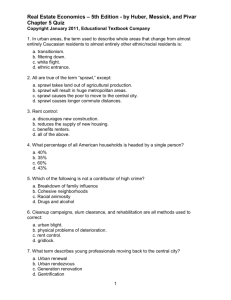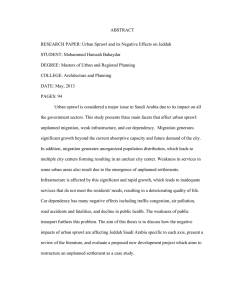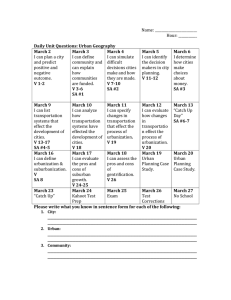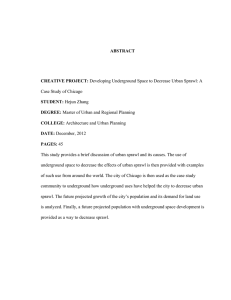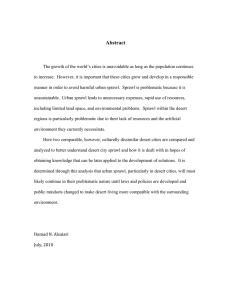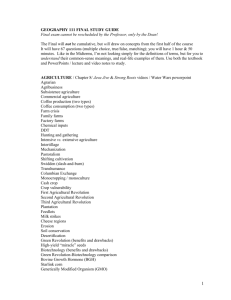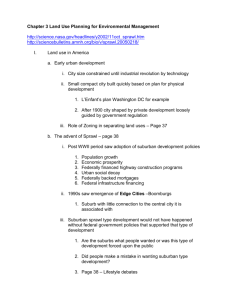Nine Causes of Sprawl
advertisement
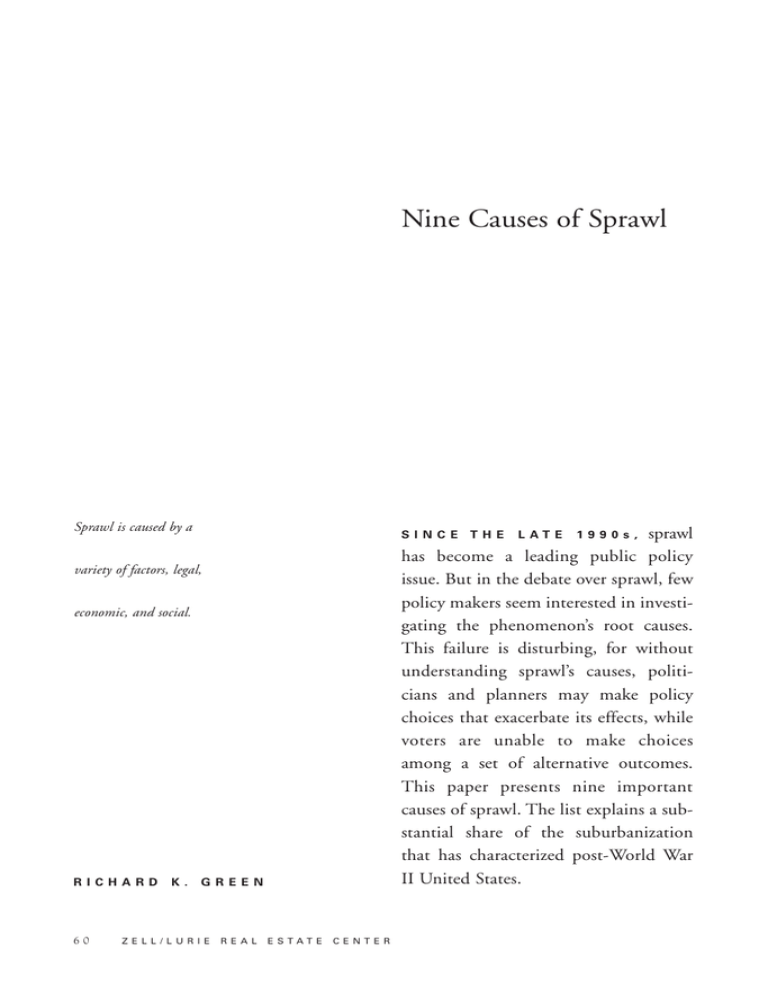
Nine Causes of Sprawl Sprawl is caused by a sprawl has become a leading public policy issue. But in the debate over sprawl, few policy makers seem interested in investigating the phenomenon’s root causes. This failure is disturbing, for without understanding sprawl’s causes, politicians and planners may make policy choices that exacerbate its effects, while voters are unable to make choices among a set of alternative outcomes. This paper presents nine important causes of sprawl. The list explains a substantial share of the suburbanization that has characterized post-World War II United States. SINCE THE variety of factors, legal, economic, and social. RICHARD 60 K. GREEN ZELL/LURIE REAL ESTATE CENTER L AT E 1990s, THE RENT GRADIENT Modern urban economics has its roots in models developed by William Alonso, Edwin Mills, and Richard Muth. These models show that two key determinants of urban land values are the value of undeveloped land at the metropolitan area edge and the cost of transportation. Put simply, it is desirable to be near the hub of commercial activity, so people who live near job centers pay more for land and those living near the periphery pay less. Where land is relatively expensive, it makes sense to economize its use. Therefore, building densities will be high in places with high land values. For that reason, the densest developments tend to be near city centers. Conversely, the land on cities’ peripheries is relatively inexpensive, so building densities are low. A result is that at the relatively less expensive urban periphery, each home takes up more land (houses sit on larger lots), and therefore these areas generally exhibit lower density (that is, more sprawl) than do city centers. This tendency is not necessarily a problem, because relative prices reflect the relative scarcity of resources. After all, construction components such as timber and labor are scarce resources, too. The question is whether the relative prices of land and improvements appropriately take into account all resource costs. DEMOGRAPHIC CHANGES Land use is driven partly by the composition of households. Since the end of World War II Americans are: waiting longer to marry; more likely to divorce; having fewer children; and living much longer after their children have grown. These demographic changes have caused the average U.S. household size to fall from 3.5 persons in 1940 to 2.5 persons today. Thus, even if population had remained constant and housing density had remained unchanged, the amount of land required to house the population would have risen by 40 percent between 1940 and today. It might be argued that smaller households could occupy smaller housing units, resulting in higher unit density. However, accomplishing this increase in density would not be easy. Consider an older house in the middle of a city. The house is in good condition but not easy to subdivide into multiple units, so it is occupied by (on average) 2.5 people, rather than 3.5. Multifamily units would likewise be difficult, if not impossible, to resize for smaller households. Until consumer tastes change and the existing housing stock is replaced, smaller household size will not, by itself, reduce the amount of land per capita needed for housing our population. This outcome is, arguably, benign. REVIEW 61 GROWING AFFLUENCE The United States has become more affluent. Households at all economic strata are materially better off now than they were in 1945 (or in 1965, for that matter). At the top end of the spectrum, the number of households earning in excess of $100,000 in real income has increased sixfold over the last ten years. The effect that affluence has had on land use is profound from two perspectives: an income effect and a substitution effect. The income effect could be called the “George Carlin effect;” that is, as people have more money, they want more “stuff,” including larger houses on larger lots. The substitution effect chiefly concerns transportation. For example, if a large share of household income is spent on transportation, a family might want to economize, or better still avoid its cost altogether, by living in the center of a city. Conversely, as transportation becomes relatively less costly, people might seek to economize on land cost, and will therefore move to places (the suburbs or exurbs) where the per unit price of land is low. In the context of contemporary society, transportation costs are largely fixed; while acquiring and maintaining a car are expensive, the cost per mile for driving is small (though this may ultimately change as gas prices keep rising). Therefore, while transportation concerns dictate location deci- 62 ZELL/LURIE REAL ESTATE CENTER sions for low-earners, transportation costs are relatively unimportant for highearners. Thus for high-earners, who are the chief market for new suburban housing, rising affluence leads to greater land consumption. T R A N S P O R TAT I O N According to Joel Garreau’s Edge City, “the maximum desirable commute, throughout human history, regardless of transportation technology is forty-five minutes.” When people in ancient times walked to work, cities could extend only a mile or two. Omnibuses and streetcars increased this distance. With the use of private automobiles, and average driving speeds of 30 miles per hour, people today can live ten miles or more from their workplace. Garreau demonstrates that development has responded to the desired 45-minute commute by placing office space on the periphery of cities, so that commuters can avoid the density and traffic of downtowns. As a result, the amount of office space in suburbs is now generally greater than the amount in traditional downtowns, and the most common commuting pattern in America today is from suburban home to suburban office. Households’ desire to reap the private benefits of low density while avoiding lengthy commutes has pushed cities to spread out. These results would be ideal if households bore the full costs of their commuting. But they do not. For example, the City of Milwaukee’s Department of Administration calculates that automobiles in that city cost society about $400 apiece each year beyond what their owners pay in licensing fees and gasoline taxes. These added costs relate primarily to congestion and pollution. What is remarkable about the $400 figure is that Milwaukee has relatively little congestion, as large American cities go. In many cities, the costs are certainly much higher. One method for making commuters pay these costs is to increase fuel taxes. For instance, someone who drives 10,000 miles per year in a car that gets 25 miles per gallon uses 400 gallons of gasoline per year. Increasing the gasoline tax by $1 per gallon would internalize the costs of congestion. But according to this argument, in places such as rural areas where congestion costs are much lower, gasoline taxes should also be lower. This would give metropolitan area residents an incentive to drive outside their cities to buy their gasoline. An important question remains as to whether people’s time is sufficiently inexpensive that it is worth their while to go out of their way to buy gas. Other potential methods for internalizing commuting costs include highway tolls and commuter taxes. It could be argued that all such taxes have strengths and weaknesses, and that all are politically difficult to implement. But the consequences of underpricing the social cost of automobile use have also led to politically unacceptable outcomes. GOVERNMENT SERVICES Economist Charles Tiebout pioneered the idea that local units of government compete with each other for citizens. Specifically, he argued that local officials put forward packages of services in return for a given tax level, in the hope of attracting people and capital to their communities. This theory is supported by empirical evidence suggesting that people respond to service packages. Although it is often suggested that people seek to avoid taxes at all costs, work by Therese McGwire, Michael Wayselenko, and others has shown that people do prefer communities with better services, and tend to move to cities that provide the services they want at the lowest possible tax costs. This competition puts newer cities at an advantage relative to their older counterparts. First, old cities’ infrastructures tend to be old and often inadequate, and replacing infrastructure is very expensive. Newer cities can offer better infrastructure at lower cost. Second, and perhaps more important, newer cities have often used land regulation to prevent the construc- REVIEW 63 tion of low-priced housing. Old cities, on the other hand, have large amounts of old (low-priced) housing, which tends to attract low-income owners and tenants. Low-income people, who require a disproportionately large share of public services, are therefore concentrated in central cities. This concentration of individuals drawing on public resources puts central cities at a fiscal disadvantage as they try to offer “middle-class” benefits. Newer cities, on the other hand, can provide these services at lower levels of taxes. Lower taxes attract the middle class, a migration that further increases the concentration of poverty in the older cities, which in turn worsens the older cities’ competitive position. Edward Glaeser has argued that, because of this middle class exodus, higher levels of government (perhaps the federal government) should take responsibility for income redistribution and social services spending if older central cities are ever to become more competitive. To make matters worse, older cities have often been run by politicians who are overtly hostile to private development in their jurisdictions’ central areas. This hostility stands in contrast to newer cities, which provide low tax rates on industrial parks and use tax-increment financing (TIF) to stimulate business development. Older cities are already at a fiscal disadvantage relative their less aged counterparts. 64 ZELL/LURIE REAL ESTATE CENTER But when the political class that runs an older city erects hoops (such as “pay-toplay” in Philadelphia) through which businesses must jump before they are allowed to develop, the fiscal disadvantages of the community grow even larger and harm the city and its residents. RACIAL D I S C R I M I N AT I O N Racial discrimination remains a central fact in U.S. housing markets; the statistical evidence, while in itself not conclusive, is nevertheless overwhelming. Leaving aside, for the moment, the moral repugnance of discrimination, discriminatory behavior is harmful because it generates perverse incentives, thus producing economically unappealing outcomes. One unwanted outcome is unnecessary sprawl. For example, “white flight,” by definition, requires development of land that would not be developed absent race-related behavior. And while discrimination may have become a less pervasive element of individual minority group members’ treatment in the housing arena, the rising share of minorities in American society means that discrimination could become an increasingly destructive feature of the housing market in the years to come. Consequently, one of the most important things that governments wishing to attack sprawl can do is to vigilantly and strictly enforce fair housing laws. After more than 30 years of federal fair housing laws, we still observe widespread patterns of discrimination and segregation, as numerous credible studies have shown. As time passes, it becomes clearer that testing is likely the only effective mechanism for enforcement. Testing involves sending equally financially qualified white and minority buyers and tenants into the housing market, and determining whether they are disparately treated. Disparate treatment implies discrimination, and thus is illegal. Putting widespread testing into practice is a severe and expensive means of enforcing fair housing laws, but if we, as a society, are serious about eliminating the blot of housing discrimination, we must do something serious in response. at a price that is agreeable, then the developer of the facility can find another place to locate. By contrast, city centers tend to be characterized by many small parcels owned by different people. As a result, the owners of the last few parcels needed by a developer have monopoly power in setting price. Once the developer has bought the majority of parcels she needs, she may not be in a position to walk away from outrageous asking prices sought by a few holdout owners whose land is needed for the assembly to be complete. The periphery has another substantial advantage over the central city: property on the periphery is generally environmentally “clean,” while central city parcels often require costly environmental cleanups. FEDERAL HOLDOUTS AND LAND TA X INCOME POLICY A S S E M B LY From at least one perspective, redeveloping at the city center always has a disadvantage relative to new development at the urban periphery: the cost of land assembly. Suppose that a company is considering where to locate a new manufacturing facility. If it can get zoning approval from the local government to develop at the periphery, then the company can negotiate an option to purchase from one landowner, typically a farmer. If the farmer will not sell Federal tax policy has generally favored development on the periphery of cities. A striking example is the mortgage interest deduction (MID), which lets a household deduct home loan interest from ordinary income in determining its federal income tax liability. The MID is a residual part of the original tax laws; it was not designed to stimulate housing: the original 1913 federal income tax code allowed for deducting all consumer interest. The Tax Reform Act of 1986 phased out consumer interest REVIEW 65 deductions, with one prominent exception: interest on a home mortgage loan. In fact, the MID has done little to promote home ownership. The reason is that for those at the margin of home owning, the MID is not worth very much. Someone who pays little in property and state income tax might find that, even with the MID, the standard deduction is more valuable than itemization. Even for those who itemize, the MID can have little value, because the typical marginal federal income tax rate for low to moderate income families is 10 percent: each dollar paid in home mortgage loan interest is worth a mere 10 cents in tax relief. Contrast this situation with that faced by those higher up the income scale, where each dollar of deduction is worth between 25 cents and 45 cents, depending on the marginal tax rate. Of course, households with higher incomes are likely to own their homes regardless of the tax treatment of mortgage loan interest. Note that in Canada and Australia, countries without mortgage interest deductions, home ownership rates are quite similar to the rate in the United States. On the other hand, the MID encourages high-income households to buy more expensive homes than they otherwise would, because the size of the implicit subsidy increases for costlier residences, up to a point (interest can be deducted only on up to $1.1 million of home loan debt). 66 ZELL/LURIE REAL ESTATE CENTER More expensive houses generally sit on larger lots than do less expensive homes. The tax code’s encouragement for buying relatively expensive houses therefore contributes to sprawl. The tax treatment of parking had a more subtle effect (since 1999, workers have been able to pay for parking and other transportation expenses on a pre-tax basis). A firm on the Chicago periphery, where land was relatively cheap, could pave some acreage and provide free parking for its employees, a benefit on which users pay no income tax. Workers in the Loop, on the other hand, typically paid to park, a cost the IRS viewed as personal and therefore not deductible. (Parking in major downtown areas is uniformly expensive since the opportunity cost of land is too high to allow workers to park cheaply.) All things being equal, the suburban employee is better off. The implication was that the tax treatment of parking gives firms incentives to locate on the periphery, where land is cheap, rather than in city centers. This incentive was largely neutralized with the Tax Act of 1998, which went into effect in 1999. LAND USE R E G U L AT I O N I have already discussed how newer communities use land use regulation to prevent settlement by low income households, and how this activity contributes to sprawl. But even seemingly innocuous land use regulations can cause more land to be used than is necessary to house a given number of people. These regulations fall into a variety of categories, including setback, minimum lot size, street width, and, ironically, green space requirements. Simply put, all of these policies reduce the number of housing units that can be placed within a particular land area, in turn reducing population density, which, perforce, creates sprawl. World Bank planner Alain Bertaud has shown how seemingly small changes in these regulations can have a large impact on the number of housing units that can be fit into a particular land mass. CONCLUSION Sprawl has a variety of causes, some benign and others malignant. If policy makers are truly concerned about the malignant underpinnings of sprawl— discrimination, fiscal zoning, transportation that imposes social costs, federal tax policy, and regulations that needlessly consume land for residential development—then they will deal with these causes directly. Otherwise, we will know that they, and their voting constituents, are content with the way things are. A slightly different version of this article appeared in the University of Illinois-Urbana-Champaign Real Estate Letter. REVIEW 67

